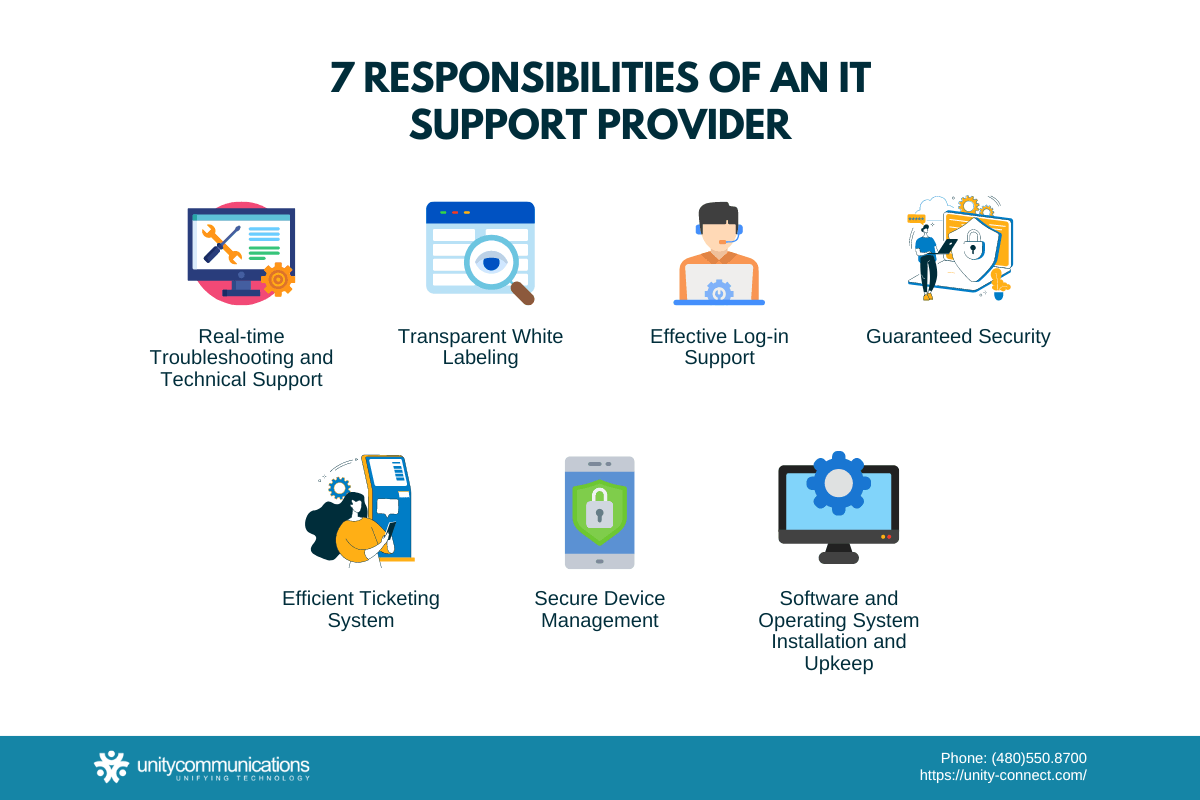Table of Contents
Are you thinking about outsourcing information technology (IT) desktop support? You should.
Service desks are a crucial part of an organization, no matter how difficult and costly they are to manage. End users need immediate and responsive technical assistance. You must ramp up IT support as your company grows and acquires more customers.
This article explores how IT support outsourcing increases your service capabilities. It also discusses the indicators for outsourcing, its pros and cons, and the role of desktop support providers.
What Does Outsourcing IT Desktop Support Mean?
Outsourcing IT desktop support involves relying on an external service provider that specializes in technical assistance or customer service. Companies acquire a back-office outsourcing team or software that sends automated responses through this strategy.
Because of outsourcing’s benefits, many companies choose outsourced technical support over in-house departments. Business process outsourcing (BPO) providers have tried and tested procedures that they use to solve customer problems. So not only do companies save time and resources by delegating their non-core tasks, they also get better service quality and space to focus on core initiatives.
Outsourcing increases the value and speed of analytics. Reports show that data analytics help organizations reduce phone calls by 10%, save up to 670 working hours annually, and keep 25% of help desk resources accessible and available.
Outsourced solutions are also cost-effective. Hiring a third-party IT provider is an excellent choice if businesses want to cut costs. They no longer need to buy new infrastructure, rent a bigger office, or invest in advanced software and tools. Reducing labor expenses is also possible with outsourcing.
Seven Responsibilities of an IT Desktop Support Provider

What is an outsourced IT provider’s responsibility? A short answer is “a lot.”
They give customers, employees, and vendors immediate technical assistance. An organization can encounter several IT issues, and desktop support is its first line of defense. A typical service desk can help through the following methods.
1. Real-time Troubleshooting and Technical Support
Most agents’ work involves break/fix support and issue management. IT desktop support identifies and fixes the root cause when a computer is not running the way it should. If your new speaker works on Zoom but not on MS Teams, save yourself time and stress by asking the help desk.
The service desk also assists users with network and connectivity issues. Problems with flash drives and printers are other common help desk tickets. The technical support agents’ daily workload can include making recovery files or solving the dreaded “blue screen of death.”
2. Transparent White Labeling
Service providers also offer white-label technical support on behalf of their clients.
Suppose you are outsourcing IT desktop support to Unity Communications. When a shopper submits a service request, it appears that the customer is talking directly to your business.
White labeling connects the outsourced service desk to your business. It lets you present top-notch support services as your own, adding to your business reliability.
3. Effective Log-in Support
Entering a wrong password, username, or personal identification number (PIN) too many times locks you out of your accounts and devices. Help desk technicians are the ones to turn to for login assistance. They verify your identity and help you regain access to your systems.
Try asking a service desk technician what they do for a living. Chances are that they will joke about resetting login credentials all day. Password resets are one of the most popular technical support tickets, but there is more to outsourcing IT desktop support.
4. Guaranteed Security
Security plays a crucial role in back-office outsourcing services. Hackers who want to get into an account or device first try to get a password reset from service desks.
Compared to legacy methods such as security questions, advanced privacy solutions make it easier for support agents to verify a user’s identity. With this, service desks can pinpoint threat actors with maximum certainty and prevent unauthorized access.
5. Efficient Ticketing System
IT desktop support uses a ticketing system to receive and filter service requests via phone calls, chat, email, or apps. Each request is ticketed so that the service desk technician can track its status throughout service delivery.
Suppose the first contact technical support agent cannot find a solution. In that case, they escalate the ticket to the next-best individual or department. When outsourcing IT desktop support, each request gets routed until the appropriate technician resolves and closes the ticket.
6. Secure Device Management
Employees use desktops, laptops, smartphones, and tablets to do their jobs. If your monitor’s screen breaks or a printer stops working, you cannot just go to the IT closet to find a replacement. The device management team oversees all computers and mobile gadgets in the office.
Device management involves procuring, distributing, and administrating devices within an organization. Seventy-four percent of companies plan to continue remote work, making device management more challenging.
A modern service desk approach gives you what you need when you need it. More importantly, providers understand that device management is more than just purchasing and delivering computers. They ensure desktops, laptops, and mobile devices receive regular maintenance to keep them running at maximum capacity.
7. Software and Operating System Installation and Upkeep
Outsourced tech solutions manage devices on your behalf while also assisting with upkeep. This involves getting new operating systems, regularly updating software, and installing essential applications onto a device. Technicians can do these things from a distance, but sometimes they might need to physically interact with the devices.
Four Factors To Consider When Outsourcing IT Desktop Support

Outsourcing IT desktop support is not a new concept. For years, businesses have used this strategy due to its many advantages.
Ready to dive into IT desktop outsourcing? Below are some factors to consider.
1. Transparent Pricing
Outsourcing is an incredible way to save on costs while addressing service desk inefficiencies. Still, you should know all fees involved before committing. Moreover, ensure your BPO partner is transparent about billing and additional costs to avoid surprises when it is time to pay.
2. Clear Division of Responsibilities
Make sure to know your roles and responsibilities when hiring an outsourced desktop support provider. Get to know who is in charge of the equipment and who is responsible for dealing with potential hardware issues.
3. Sufficient Resources and Infrastructure
When your business relies on outsourced IT solutions for basic tasks, managers and agents should know whom to reach out to when a problem arises. A third-party team should have the necessary tools, knowledge, and skills to ensure continuous daily operations.
4. Robust Training and Onboarding Process
Understand the hiring and onboarding process before signing a contract. Be open to training and seminars provided by the BPO company to align all expectations and deliverables. You might also need to teach agents your standard operating procedures and company policies before you send them out.
Pros and Cons of Outsourced IT Desktop Support

The main advantage of outsourced IT desktop support is cost savings. Outsourcing is cheaper than in-house production because of different economies of scale.
Companies can also save money by contracting shared technical support agents who cover multiple businesses simultaneously. A fixed-price contract determines the amount due every month, so you can budget funds efficiently.
Still, you must consider some disadvantages. First, cost savings might not hold true, especially when the BPO company underperforms or fails to meet your criteria. Second, the service quality might hurt customer care. Finally, remedial solutions might be delayed when additional costs and actions require the client company’s approval.
Let’s take a closer look at the pros and cons of outsourcing.
Advantages of Outsourced IT Desktop Support
Outsourcing IT desktop support has many benefits beyond costs, including:
- Increased availability. BPO companies let you tap into shared resources at night or during periods of low activity, so your help desk still runs beyond working hours.
- Support for more channels. Digital channels saw a 36% increase in transaction share in the previous years. Outsourcing helps you provide omnichannel support so that users can choose their preferred platforms when talking to agents.
- Best practice processes. Best practices differentiate your brand from competitors. They also help you optimize your operation to save more money.
- Higher capabilities. BPO companies allow you to access additional capabilities and help clients fulfill their IT goals.
- Additional technical knowledge. Based on outsourced IT trends, some technical skills are in high demand. As a result, experts have high salary expectations and are difficult to find and retain. Outsourcing lets you access quality talent for a lower price.
- Wider geographical support. Your service provider can offer multilingual agents to accommodate different geographical locations.
- Better benchmarking abilities. An outsourced service desk can better measure performance against benchmarks and industry standards than an in-house team. Service-level agreements (SLAs) will likely have targets aligned with industry benchmarks.
Disadvantages of Outsourced IT Desktop Support
Outsourcing IT desktop support can also bring the following disadvantages:
- The help desk does not align with the company’s culture. This causes friction and a gap in how end users receive treatment from service desk technicians.
- Agents have a superficial understanding of your business operations. This means that the impact and context of IT problems are incorrectly understood and handled.
- The service quality might be affected. For example, when you outsource data entry services, staff performance might be affected by differing training methods.
The Bottom Line
Getting your service desk right is crucial. Your BPO partner can help you establish robust security measures, manage tickets, and provide immediate troubleshooting to end users.
Because IT support is essential to customer experience, craft your outsourcing plan carefully. Consider the resources, pricing, onboarding process, and service quality you need.
Give your customers a service desk that knows your product by heart and is skilled at handling support tickets. Contact Unity Communications now.



